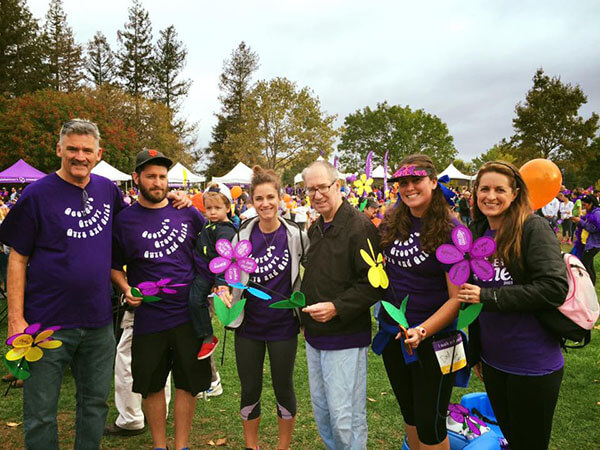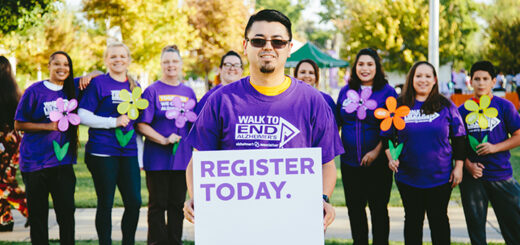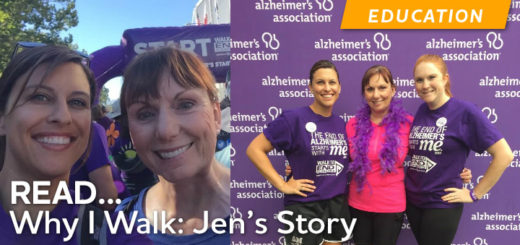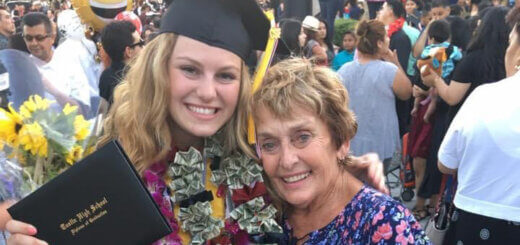Two dementia caregiving journeys for one Bay Area woman
Genevieve’s mother was diagnosed with breast cancer and later dementia. Genevieve’s father and sisters helped to care for her mother until she passed in 2008. Assuming their father was in the grieving process, Genevieve and her sisters missed the signs that their father also had dementia. 12 years after her first Walk to End Alzheimer’s®, Genevieve now volunteers her time to encourage companies to support Walk to End Alzheimer’s.
Peggy and George
George Soares and his wife Peggy met while they were in college in New Jersey. “Dad went to Rutgers and Mom went to Douglass College,” said their daughter Genevieve Soares. “Mom met my dad and his friend at the library, but started dating my Dad’s friend first. It didn’t work out because he [the friend] was also dating someone else. When they broke up, Mom started dating my dad.”
Peggy and George were married a few years later when Peggy was 21. They were both being intrigued by California, so when George was accepted at UC Berkeley for his PhD program in entomology, they moved to the Bay Area. While living there, Peggy decided to get her teaching credential, also from UC Berkeley.
After having their first child, Peggy started a preschool with friends. However, Peggy had dreams of returning to live in France where she had done a study abroad program as an undergrad in college. As she and George tried to figure out how to get there, George took a job in Washington D.C. Eventually he found a post-doctoral position at a lab in Paris. Within a year of moving there, Genevieve was born.
Eventually the family moved back to California, settling in San Diego where Peggy and George had their third child. “We grew up always going places,” said Genevieve. “Whether it was across the country for family visits (all of our family lived on the East Coast), European trips or road trips up the coast. We grew up camping and hiking and visiting tide pools in La Jolla. My family was very into nature. It’s fun for me to realize that so many of the things I love, camping, scuba diving, running and singing, come from my parents.”
Multiple diagnoses
When Peggy was 50, she was diagnosed with breast cancer. She went through chemotherapy and radiation before going into remission. Shortly thereafter, Peggy noticed that she was forgetting things. She could no longer remember how to French braid her daughter’s hair and would forget meetings at work.
Because of her young age, doctors didn’t even consider the possibility it could be dementia. “They went through five or six different diagnoses,” said Genevieve. “They prescribed different medications, but they never worked.”
Health care providers generally don’t look for dementia in people under the age of 65. This can make getting an accurate diagnosis of early-onset dementia a long and frustrating process. Symptoms may be incorrectly attributed to stress or there may be conflicting diagnoses from different health care professionals.
Finally, at age 55, Peggy was diagnosed with younger-onset dementia. Younger-onset (also known as early-onset) dementia affects people younger than age 65.
Taking the bus
After the diagnosis, Genevieve and her family decided that Peggy needed to stop driving. Driving requires the ability to react quickly to a variety of circumstances. Because of this, a person living with dementia will, at some point, be unable to drive. “That was pretty hard,” said Genevieve. “It was a big piece of her independence.”
Despite her family’s concerns, Peggy continued to drive and ended up in a minor accident. Thankfully, no one was hurt. After that, Peggy decided to master the bus system.
“She always loved pottery,” said Genevieve. “She started taking pottery classes at the community college, which was 30 minutes from home. She figured out the bus system to get to her classes and back. She was motivated to keep doing the things she loved as long as she could. She was very talented; I still have an incredible fish sculpture she made.”
Starting a Walk team
In 2008, ten months before she died, Peggy and George moved to the Bay Area to live with their eldest daughter. Peggy and her daughters would participate in the breast cancer three day walk. Genevieve said, “It was something important to her.” Three weeks before she died, Genevieve and her sisters walked one more time in her honor.
However, after their mother’s death, it occurred to Genevieve and her sisters that a more appropriate way to honor their mother, who died with dementia, was to join a walk against dementia. They were pleased to find Walk to End Alzheimer’s.
In 2009, Genevieve and her family started the team, Peggy’s Pink Ladies, and participated in multiple Walks across the country. The bulk of the family walked at the San Francisco Walk to End Alzheimer’s.
Missing the signs
Because everyone was so invested in Peggy’s care, no one noticed that George had also begun to show signs of dementia. “Mom had been the main breadwinner at the time of her diagnosis,” said Genevieve. “She had paid the bills and now it was all on Dad. He had to find work again and was struggling. We thought it was just stress.”
Once Peggy died, George needed to figure out what he was going to do with the rest of his life. He decided to live with his father who spent half of the year in Florida and half of the year in Portugal. “At some point we realized something was wrong and it was getting worse,” said Genevieve. “My dad was very good at hiding that anything was wrong. It was hard to convince relatives.”
Genevieve and her sisters were finally able to convince their grandfather and aunt to take George to a neurologist to get evaluated. After taking some tests, George was diagnosed with dementia. “He didn’t believe it,” said Genevieve. “He wanted a second opinion at UCSF. We ended up moving him back to the Bay Area to live with my sister.”
Eventually, George’s eldest daughter and her family moved to Arkansas. Having nowhere else to go, and incapable of caring for himself, George moved with them. In 2015, after living in Arkansas for four years, George moved back to the Bay Area and into a care setting in Oakland.
At first, he was in assisted living, but the move caused him to decline even further. Three months later, George moved into memory care. Currently, George is living in a care setting in Livermore.
Becoming a volunteer
This year Genevieve saw an email asking if she would be interested in volunteering for the East Bay Walk to End Alzheimer’s. “With it being a weird year [because of the pandemic], I thought this would be interesting,” shared Genevieve. “I have a sales background, and when they talked about the different committees, they mentioned Corporate Engagement. I thought that could be the right fit for me.”
Corporate Engagement Subcommittee members look for ways to engage companies within their community. Many companies in the United States are unknowingly impacted by the disease. They encourage companies to support the mission of the Alzheimer’s Association® by sponsoring and/or participating and fundraising in Walk to End Alzheimer’s.
The Alzheimer’s Association’s Facts and Figures report states that nearly 10 million dementia caregivers are employed and work an average of 35 hours per week while caregiving. Over 25% of dementia caregivers are in the sandwich generation, providing care for at least one child as well as aging parents.
According to the recently released California Department of Public Health Alzheimer’s Disease and Related Dementias Facts and Figures in California report, employers annually lose $8.3 billion in productivity due to employees having to balance work and caring for someone with dementia. The majority of those costs ($5.3 billion) come from having to replace employees who have to leave the workforce because of their caregiving responsibilities. Some companies have put programs and policies in place to help support their employees who are caring for a loved one with dementia.
“Being on the committee has been a nice way to connect with people who understand the struggle and have similar stories as me. It’s great and I’d like to continue doing this next year.”
Same team, new name
Currently, Genevieve’s sisters both live out of state, but it hasn’t kept them from continuing to raise funds and participate in a Walk near them. Genevieve and her sisters decided they needed to change their team name to honor their father. They are now called George’s Groovy Guys and Gals.
The East Bay Walk is taking place on October 23 at Bishop Ranch in San Ramon. For those who prefer to Walk From Home, they can still engage in many Walk-day experiences through a mobile app.
The Alzheimer’s Association is planning every Walk with the health and safety of constituents, staff and volunteers as the top priorities. All events will implement safety protocols including physical distancing, masks (where required), contactless registration, hand sanitizing stations and more. Staff continue to closely monitor Centers for Disease Control and Prevention (CDC), state and local guidelines to ensure Walk events adhere to recommendations and are safe for attendees.
“I’m excited to do something in person this year,” said Genevieve. “I’m also excited to see the Walk from a volunteer perspective. I think it will feel good to know I had a hand in making things happen. My favorite part is the promise flower ceremony. It’s very powerful when they have someone living with the disease represented on stage.”
Tips for other caregivers
When Peggy was first showing signs of dementia, Genevieve was a junior in college. The thought of finding an organization to help never crossed her mind. Now that she’s older she realizes that this was a mistake and has some suggestions for other caregivers. “Definitely look to the Alzheimer’s Association to see what support and resources they have,” Genevieve recommended. “I wish I’d been better at the beginning.”
Genevieve also encourages caregivers to be patient both with themselves and the person living with the disease. “Take time for yourself and be kind to yourself,” shared Genevieve. “It’s a hard thing to go through. Enjoy every moment even if it’s not what you expected. With my parents all I saw was more love and more cheer. It has been interesting to see how they’re different, but it has been some of the best parts of them coming out a bit more.”
You can join Genevieve’s team, George’s Groovy Guys and Gals, or form your own team and join us for the East Bay Walk to End Alzheimer’s on October 23 at Bishop Ranch in San Ramon. Or join us for the San Francisco Walk to End Alzheimer’s on November 6 at Pier 27 on The Embarcadero. Not in the Bay Area or want to Walk from home? Find a Walk near you at alz.org/walk.
Learn More:






















